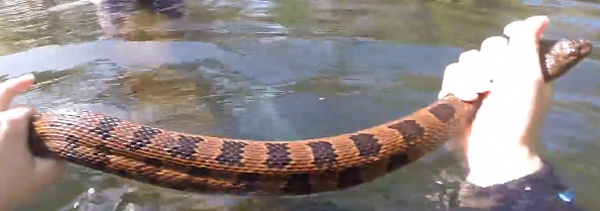- info@wildlifeanimalcontrol.com
Call us for help in your town
Wildlife Control Education
The Brown Water Snake
The Brown Water Snake is scientifically referred to as “Lycodonomorphus rufulus”, is one of the largest non-venomous snakes in the world. It native to the South-Eastern part of the United States of America, and can also be found in some parts of the Southern African region. Some people also refer to this snake as “Water Pilot, “Pied water snake” , or “water rattler”

Appearance
The Brown water snake is characterized by heavy body and it is larger than most snakes in the world today. It has a neck that is considered narrower than the head, it also has a brown colour dorsal region ( the colour may also be referred to as dusty brown). The adult snake has up to 25 dark brown or black patches on the back region, while smaller blotches are found on the sides. The ventral region is characterized by yellow colour with some marks of brown or black colours. The scales on the dorsal region can be between 27 and 33 rows with up to 4 anterior temporals. An average adult Brown water snake can measure between 30 and 60 inches in length ( A record-breaking measurement of 69 inches has been recorded in the United States).
Biology
The snake is a cold-blooded animal, usually found in swamps and streams where temperatures can be cool. Its large body structure makes people mistake it for a venomous snake. The snake is known to use its weight to crush its predators and preys and usually enjoy moving out in the warmest parts of the day while hiding in the swamps at night.
Find out more: Does rope act as a snake repellent?
Life cycle
The snake engages in mating during the Spring season, especially on land or on tree branches. The average female snake is larger than the male. The young of the snake is born alive most especially around August. In most cases, an average adult female can breed between 14 and 58 ( in most cases between 30 and 40). A typical new born should measure between 7 and 11 inches in length while males are normally lengthier than females. The life cycle of a typical Brown water snake is between 6 and 48 months.
Habitat
The snake is found in a wide range of habitats but it predominantly prefers the warm rain forest and lower coastal regions. It can be found mostly in South-Eastern region of the states of Virginia, South Carolina, North Carolina, Missouri, Mississippi, Alabama, Northern Georgia, and Louisiana. The snake can survive from the normal sea levels up to 500 ft. or 150m above sea level. This snake is also capable of moving through the sea at incredible speed.
Learn more: Where to relocate a trapped snake
Diet
Brown water snake can consume any animal in the swamp and streams, these include; smaller reptiles, birds, toads, lizards and insects.
Behavior
Brown water snake is a lone ranger and enjoys hunting alone. It is quite gentle but steady in hunting and immediately it catches a prey, it chokes and strangle it to the ground.
Go back to the How to get rid of snakes home page.
Need snake removal in your hometown? We service over 500 USA locations! Click here to hire us in your town and check prices - updated for year 2020.

















